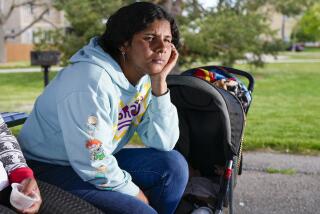Bringing Care to Baja’s Rural Poor
- Share via
CABO SAN LUCAS, Mexico — Six miles from the bay-front luxury hotels and picturesque rock outcroppings of this tourist attraction, postcard splendor gives way to squalor.
From the heights of Colonia Lomas del Sol, a dust-blown shantytown next to a dump, the tony beach zone appears a far-off world. Here, there are dirty streets, an uncertain supply of drinking water, and maladies of the sort that poverty likes best: parasites, poor nutrition, infections, bad teeth.
For nearly a decade, the community’s 7,000 inhabitants--and their health troubles--have drawn a group of volunteer medical professionals from Southern California who have built a clinic to treat residents too poor to afford a doctor.
The group, Doctors of Charity, visits every two or three months, throwing open the clinic’s doors for a day. Residents line up about dawn and most times stream in until dusk--often as many as 400 by day’s end. Treatment and medicines are free. The pace is frenetic, the need substantial.
“It would be a terrible loss if they ever left because a lot of families depend on them,” said Jose Aleman, who works for the Cabo San Lucas city government and is volunteer liaison between the doctors’ group and the neighborhood.
The project is the brainchild of Michael Purcell, a former developer from Newport Beach who was introduced to Lomas del Sol by a friend during a Cabo fishing trip nine years ago. At the time, the colonia held 700 people who were relocated next to the city dump after a hurricane destroyed their homes.
Purcell, who had done humanitarian work in India and elsewhere in Mexico, was appalled by conditions in the neighborhood: hovels lining dirt tracks, no running water, no electricity. He knew doctors were needed.
Since 1993, Purcell has sponsored dozens of visits by groups of doctors, nurses, pharmacists and other volunteers. Begging donations and dipping liberally into his own pocket, he helps cover the costs of air travel. The volunteers stay in inexpensive lodgings in Cabo San Lucas and get around in a 19-year-old Chevy Suburban that needs constant repair. The clinic was built on a site donated by a Mexican government agency.
“It’s a real bootstrap type of thing,” said Purcell, who is 71. “But it works.”
Doctors of Charity is one of numerous U.S. volunteer groups providing care--from checkups to dental work to eye exams--in impoverished spots in rural Mexico. At least two California organizations visit hard-to-reach areas by flying in private planes. It was such a group that gave Purcell the idea for the Cabo San Lucas project.
Conditions have improved in the neighborhood. There is water--though only sporadically--and electricity. The dump was closed at Purcell’s repeated urging.
Still, health problems persist and alternatives for care are limited. A nearby clinic offers subsidized treatment, but residents said it often is closed or has long lines. A similar clinic sits a bus ride away in town, but the fee of 50 pesos--about $5.50--is more than many can afford, residents said.
So it is welcome news when volunteers, driving through Lomas del Sol and two nearby communities with a bullhorn, announce that the charity group is coming.
On a recent Saturday, the contingent included Purcell, three doctors, a physician assistant, a pharmacist, three translators and a prosthetist, who was delivering a titanium leg she built for a man disabled three years ago in a car accident. During six hours, the volunteers, working quickly in bare rooms behind makeshift curtains, treated about 200 people, mostly children. Ailments ranged from strep throat and ear infection to pinworm and psoriasis.
Filomena Silvestre, who arrived from the state of Guerrero two years ago, said her four children had never been to a doctor before. Her 3-year-old son and 6-year-old daughter had chalky, dry skin--diagnosed as psoriasis--on their elbows, knees and behind the ears. The boy’s baby teeth had rotted to black nubs, and his permanent teeth would probably emerge damaged, said Gale Lawrence, a Seal Beach physician on her first trip with the group.
Silvestre, nursing a baby, said through an English-speaking interpreter that she felt pain between the shoulder blades. Lawrence checked the woman’s breathing and concluded that the mother’s back muscles were sore from toting the child.
The family shuffled to the clinic’s pharmacy, a collection of plastic bins packed with donated medications: ear drops, diabetes medicine, aspirin, inhalers, antibiotics and creams. Tajinder Gill, a San Diego pharmacist, dispensed pills and tubes of cream into zippered sandwich bags and gave instructions, through an interpreter, on taking the medicine.
Silvestre was grateful.
“It’s very good because I could not afford these medications,” said Silvestre, whose husband works as a mason’s helper.
In another room, Silvina Rojas worried that her 6-year-old grandson wasn’t eating. “Just candy,” she said. Hank Parker, a physician assistant from Laguna Niguel, said that many of the patients here know little about proper nutrition. “Basic things that you and I take for granted as common knowledge--these people don’t know,” Parker said.
He explained, through an interpreter, that the boy needed more milk, more water and more healthy food, but not more candy.
The often hurried, infrequent visits by patients permit little time for the medical workers to give detailed counseling on diet, nutrition, food safety and other health topics--a reality that everyone finds frustrating. Illness is fought mainly in its immediate forms--painful ear infections, invasions by microbes. The helpers will have returned to the United States by the time their cures take hold. But some planned to return with the next delegation in July. There will be plenty to do.


